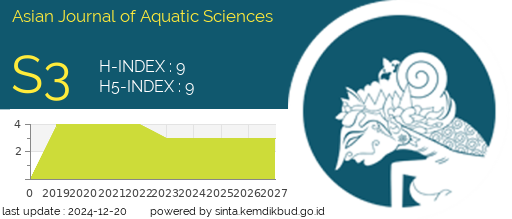THE EFFECT OF PLASTIC COVERS WITH DIFFERENT COLOR ON THE TYPE AND ABUNDANCE OF EPIPELIC DIATOMS IN THE NATURAL LOVERS INTERTIDAL AREA (PAB) CITY OF DUMAI
DOI:
https://doi.org/10.31258/Keywords:
Plastic color, Epipelic Diatoms, Abundance, Intertidal Zone, DumaiAbstract
The purpose of this study was to determine the effect of the plastic cover with different colors on the type and abundance of epipelic diatoms. This research was conducted in March 2022 which is located in the Pecinta Alam Bahari (PAB) area of Dumai City. The method used is an experimental method with plastic cover treatment with different colors. This experiment has one factor, namely plastic color, with four levels of treatment, namely no plastic (control), clear, red, and black colors. The type of plastic used is the same type of plastic. The experimental units are made of iron which is assembled with a size of 1x1m and 12 subunits are measuring 10x10 cm. Observations were made every day for three consecutive days. The results showed that there were 15 species of epipelic diatoms, where the species that were often found every day were Cosdisnodiscus sp., Gyrosigma sp., Navicula sp., and Pleurosigma sp., Skeletonema sp, Striatella sp, Synedra sp. The abundance of diatoms in the treatment without plastic ranged from 38993.8 - 68239.2 ind/cm2, the clear plastic cover ranged from 39880.04 to 67353.0 ind/cm2, the red plastic cover ranged from 31904.0 to 69125.4 ind/cm2, and the black plastic cover ranged from 28359.14 – 54945.83 ind/cm2. The results of the One Way Anova test between treatments showed a significant difference every day, except on day 0 which was not significantly different.
Downloads
References
1. Latt UW. Shrimp pond waste management. Aquaculture Consultant, 2002; 7(3): 11-16.
2. Suwignyo S, Widigdo B, Wardiatno Y, Krisanti M. Avertebrata air jilid 1. Penebar Swadaya: Jakarta, 2005.
3. Alqarni W. Pengelolaan fasilitas pengunjung ekowisata mangrove di Bandar Bakau Kota Dumai. JOM Fisip, 2017; 4(1): 1-16.
4. Carbery, Maddison, Connor WO, Thavamani P. Trophic transfer of microplastics and mixed contaminants in the marine food web and implications for human health. Environmental International (March), 2018.
5. Septia E. Waspadai kantong plastik hitam dan wadah kue. Internet. 2009; (diakses pada 2022 Juli 19).
6. Davis CC. The marine and fresh-water plankton.Michigan State University Press; East Lansing, 1995.
7. Ryan PG, Moore JM, Franeker JA, Moloney CL. Monitoring the abundance of plastic debris in the marine environment. Phil. Trans, 2009.
8. Padang, Dari AL, Latuconcina, H. The Effect of different light intensities on the growth of Navicula sp laboratory scale. Bifamika, 2013; 5 : 560 – 565
9. Sulistyaningsih E, Kurniasih B, Kurniasih E. Pertumbuhan dan hasil caisin pada berbagai warna sungkup plastik. Ilmu Pertanian, 2005; 12(1):65-76
10. Agnestika I. Kartika, Nihayati E, Sitiwati. Simulasi panjang gelombang cahaya terhadap kualitas tanaman krisan (Chrysanthenum morifolium) potong. Jurnal Produksi Tanaman, 2017; 5(7): 1187-1195
11. Pakpahan LS. Konsentrasi Nitrat dan fosfat serta kelimpahan diatom di perairan bekas pertambangan timah Kelurahan Sungai Lakam Kabupaten Karimun Provinsi Kepulauan Riau. Fakultas Perikanan dan Ilmu Kelautan. Universitas Riau. Pekanbaru, 2013.
12. Rudiyanti S. Growth of Skeletonema costatum at various levels of media salinity. Journal of Fisheries Science, 2011; 6(2):69-76.
13. Sachlan M. Planktonologi. UNDIP: Semarang, 1982.
14. Warner GF. The biologi of crab. Elek Science London. England, 1977.
15. Mohamed KN, Amil R. Nutrients enrichment experiment on seawater samples at Perhentian Island, Terengganu. Procedia Environmental Sciences, 2015; 30: 262-267.
16. Radiarta, Nyoman I. Relationship between phytoplankton distribution and water quality in the Ala Strait, Sumbawa Regency, West Nusa Tenggara. Sustainable Earth Journal, 2013; 13(2) : 234-243.







